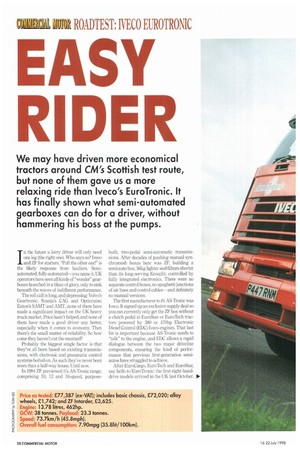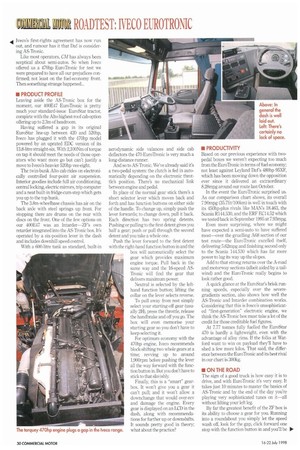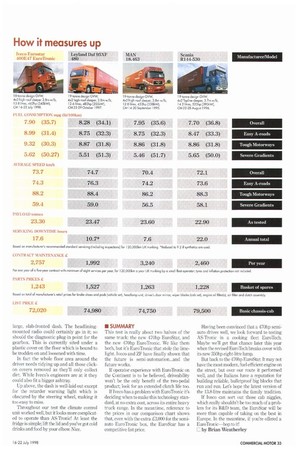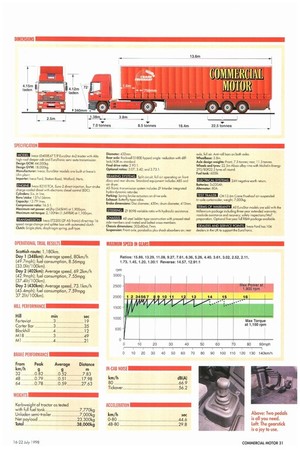ROADTEST: IVECO EUROTRONIC
Page 40

Page 42

Page 44

Page 45

Page 43

If you've noticed an error in this article please click here to report it so we can fix it.
EASY RIDER
We may have driven more economical tractors around CM'S Scottish test route, but none of them gave us a more relaxing ride than Iveco's EuroTronic. It has finally shown what semi-automated gearboxes can do for a driver, without hammering his boss at the pumps.
In the future a lorry driver will only need one leg (the right one). Who says so? Iveco and ZF for starters. "Pull the other one" is the likely response from hauliers. Semiautomated, fully-automated—you name it, UK operators have seen all kinds of "wonder" gearboxes launched in a blaze of glory, only to sink beneath the waves of indifferent performance.
The roll call is long, and depressing. Volvo's Geartronic; Scania's CAG and Opticruise; Eaton's SAMT and AMT...none of them have made a significant impact on the UK heavy truck market. Price hasn't helped, and none of them have made a good driver any better, especially when it comes to economy Then there's the small matter of reliability. So how come they haven't cut the mustard?
Probably the biggest single factor is that they've all been based on existing transmissions, with electronic and pneumatic control systems bolted on. As such they've never been more than a half-way house. Until now.
In 1994 ZF previewed it's AS-Tronic range, comprising 10, 12 and 16-speed, purpose built, two-pedal semi-automatic transmissions. After decades of pushing manual synchromesh boxes here was ZF, building a semi-auto box, 56kg lighter and 62mm shorter than its long-serving Ecosplit, controlled by fully integrated electronics. There were no separate control boxes, no spaghetti junctions of air lines and control cables—and definitely no manual versions.
The first manufacturer to fit AS-Tronic was Iveco. It signed up an exclusive supply deal so you can currently only get the ZF box without a clutch pedal in EuroStar or EuroTech tractors powered by 380 or 470hp Electronic Diesel Control (EDC) Iveco engines. That last bit is important because AS-Tronic needs to "talk" to the engine, and EDC allows a rapid dialogue between the two major driveline components, ensuring the kind of performance that previous first-generation semiautos have struggled to achieve.
After EuroCargo, EuroTech and EuroStar, say hello to EuroTronic: the first right-handdrive models arrived in the UK last October. Iveco's first-rights agreement has now run out, and rumour has it that Daf is considering AS-Ironic.
Like most operators, CM has always been sceptical about semi-autos. So when Iveco offered us a 470hp EuroTronic for test we were prepared to have all our prejudices confirmed; not least on the fuel-economy front. Then something strange happened...
• PRODUCT PROFILE Leaving aside the AS-Tronic box for the moment, our 400E47 EuroTronic is pretty much your standard-issue EuroStar tractor, complete with the Alto highest-roof alb option offering up to 2.3m of headroom.
Having suffered a gap in its original EuroStar line-up between 420 and 520hp, Iveco has plugged it with the 470hp model powered by an uprated EDC version of its 13.8-litre straight-six. With 2,100Nm of torque on tap it should meet the needs of those operators who want more go but can't justify a move to Iveco's heavier 520hp vee-eight.
The twin-bunk Alto cab rides on electronically controlled four-point air suspension. Interior goodies include full air conditioning, central locking, electric mirrors, trip computer and a neat built-in fridge-cum-step which gets you up to the top bunk.
The 3.8m-wheelbase chassis has air on the back axle with steel springs up front. For stopping there are drums on the rear with discs on the front One of the few options on our 400E47 was an Intarder—ZF"s own retarder integrated into the AS-Tronic box. It's operated by a six-position lever in the dash and includes downhill speed control.
With a 600-litre tank as standard, built-in aerodynamic side valances and side cab deflectors the 470 EuroTronic is very much a long-distance runner.
And so to AS-Tronic. We've already said it's a two-pedal system: the clutch is fed in automatically depending on the electronic throttle's position. There's no mechanical link between engine and pedal.
In place of the normal gear stick there's a short selector lever which moves back and forth and has function buttons on either side of the handle. To change up, simply push the lever forwards; to change down, pull it back. Each direction has two spring detents. Pushing or pulling to the first detent gives you half a gear; push or pull through the second detent and you take a whole one.
Push the lever forward to the first detent with the right-hand function button in and the box will automatically select the gear which provides maximum engine torque. Pull back in the same way and the 16-speed ASTronic will find the gear that delivers maximum power.
Neutral is selected by the lefthand function button; lifting the collar on the lever selects reverse.
To pull away from rest simply select your starting-off gear (usually 2H), press the throttle, release the handbrake and off you go. The box will even memorise your starting gear so you don't have to keep selecting it.
For optimum economy with the 470hp engine, Iveco recommends block-shifting two whole gears at a time; revving up to around 1,900rpm before pushing the lever all the way forward with the function button in. But you don't have to stick to that slavishly.
Finally, this is a "smart" gearbox. It won't give you a gear it can't pull; and it won't allow a downchange that would over-rev and damage the engine. Every gear is displayed on an LCD in the dash, along with recommendations for further up or downshifts. It sounds pretty good in theory; what about the practice? • PRODUCTIVITY Based on our previous experience with twopedal boxes we weren't expecting too much from the EuroTronic in terms of fuel economy; not least against Leyland Daf's 480hp 95XF, which has been mowing down the opposition ever since it delivered an extraordinary 8.28mpg around our route last October.
In the event the EuroTronic surprised us. As our comparison chart shows, its overall 7.90mpg (35.71it/100km) is well in touch with its 450hp-plus rivals like MAN'S 18.463, the Scania R144.530, and the ERF EC14.52 which we tested back in September 1995 at 7.93mpg.
Even more surprising, where we might have expected a semi-auto to have suffered most—over the gruelling A68 section of our test route—the EuroTronic excelled itself, delivering 5.62mpg and finishing second only to the Scania 144.530 which has far more power to lug its way up the slopes.
Add to that strong returns over the A-road and motorway sections (albeit aided by a tailwind) and the EuroTronic really begins to look rather good.
A quick glance at the EuroStar's brisk running speeds, especially over the severegradients section, also shows how well the AS-Tronic and Intarder combination works. Considering that this is Iveco's unsophisticated "first-generation" electronic engine, we think the AS-Tronic box must take a lot of the credit for those creditable fuel figures.
At 7.77 tonnes fully fuelled the EuroStar 470 is hardly a lightweight, even with the advantage of alloy rims. If the folks at Watford want to win on payload they'll have to shed a few more kilos. That said, the difference between the EuroTronic and its best rival in our chart is 300kg.
• ON THE ROAD The sign of a good tuck is how easy it is to drive, and with EuroTronic it's very easy. It takes just 10 minutes to master the basics of AS-Ironic and by the end of the day you're playing very sophisticated tunes on it—all without lifting your left leg.
By far the greatest benefit of the ZF box is its ability to choose a gear for you. Running into a roundabout you simply let the speed wash off, look for the gap, click forward one stop with the function button in and you'll be BR' 4 in the perfect gear for pulling away with peak torque waiting under your right foot. If the gap closes up simply click it again and you're still ready to roll. Life's never been so easy.
In Edinburgh city centre we were left feeling calm, collected and and free to concentrate on the things that really matter: braking and steering, But the best was yet to come. The A68 section of our route can be a killer with a manual, but here was a semi-auto sailing over it without so much as an electronic sneeze. And on Blackhill we found out just how fast ASTronic really is. Having gone for one upshift too many the EuroStar 13.8-litre lump started to die on its feet. No problem. Two quick clicks rearwards on the lever and we were back in the game, where a manual box would have shown us a red card and a restart.
Not only is AS-Tronic fast, it's also very, very smooth. Whether you're pulling away with 38 tonnes up, or climbing a one-inseven, there's never a hint of snatching or jerking. The 470hp six-pot is generally well matched to its semi-auto partner. Iveco specced our EuroStar with the 2.93:1 rear axle for maximum economy, although for best driveability we reckon the 3.07:1 ratio would be a better bet.
On long gradients our 'Star was beginning to run out of wind and delivered its best at around 1,400-1,500rpm although peak torque is actually developed at 1,100rpm. That said, the Iveco diesel lugs down well and can recover, given time. And with all that torque it's a very lazy drive.
We like the Iveco steering. It's light, but not too light, and very accurate, especially in the straight-ahead position where some boxes leave you sawing back and forth running in motorway tramlines.
We're less convinced by the big Alto cab's ride. The nodding action from early models is gone but it still rolls a bit too much for our liking and we reckon the guys at Turin should stiffen it up a tad. On tight turns, as the cab's electronically controlled air suspension rapidly works to keep it level, there's also a strange beeping noise from behind the driver that sounds like the opening credits of Morse. Please, Iveco, lose that too. Despite that we finished our three days in the saddle relaxed and ache-free, not least due to the excellent Isri seat and generally quiet interior, although wind spilling across the cab corners and sun visor spoils the show somewhat.
• CAB COMFORT Getting into the Alto cab is easy; getting across it is more of a chore, but once you've threaded your way past the gearlever column you can begin to enjoy the EuroStar's roomy interior, which is a real home-from-home.
The light-and-dark-grey interior is practical with a capital P. It's generally well put together and proved rattle and creak-free during our test. There's acres of storage space for the long-haul driver, from the door pockets and underbunk area up to the top lockers in the headlining—hut the cloth-trimmed locker doors didn't inspire us.
Iveco's designers should make more use of the space available in the EuroStar's large, slab-fronted dash. The headliningmounted radio could certainly go in it; so should the diagnostic plug-in point for the gearbox. This is currently sited under a plastic cover on the floor which is bound to be trodden on and loosened with time.
In fact the whole floor area around the driver needs tidying up and all those clickon covers removed as they'll only collect dirt. While Iveco's engineers are at it they could also fit a bigger ashtray.
Up above, the dash is well-laid out except for the retarder warning light which is obscured by the steering wheel, making it too easy to miss.
Throughout our test the climate control unit worked well, but it looks more complicated to operate than AS-Tronic! At least the fridge is simple; lift the lid and you've got cold drinks and food by your elbow. Nice. II SUMMARY This test is really about two halves of the same truck: the new 470hp EuroStar, and the new 470hp EuroTronic. We like them both, but it's EuroTronic that stole the limelight. Nee() and ZF have finally shown that the future is semi-automation...and the future works.
If operator experience with EuroTronic on the Continent is to be believed, driveability won't be the only benefit of the two-pedal product; look for an extended clutch life too.
If Iveco has a problem with EuroTronic it's deciding when to make this technology standard, at 110 extra cost, across its entire heavy truck range. In the meantime, reference to the prices in our comparison chart shows that, even with the extra £3,000 for the semiauto EuroTronic box, the EuroStar has a competitive list price.
Having been convinced that a 470hp semiauto drives well, we look forward to testing AS-Tronic in a cooking fleet EuroTech. Maybe we'll get that chance later this year when the revised EuroTech breaks cover with its new 350hp eight-litre lump.
But back to the 470hp EuroStar. It may not have the most modern, fuel-efficient engine on the street, but over our route it performed well, and the Italians have a reputation for building reliable, bulletproof big blocks that run and run. Let's hope the latest version of the 13.8-litre maintains the family tradition.
If Iveco can sort out those cab niggles, which really shouldn't he too much of a problem for its R&D team, the EuroStar will be more than capable of taking on the best in Europe. In the meantime, if you're offered a EuroTronic-hop to it!
E by Brian Weatherley Price as tested: £77,387 (ex-VAT); includes basic chassis, £72,020; alloy wheels, £1,742; and Z.F Intarder, £3,625.
Engine: 13.78 litres, 462hp.
GCW: 38 tonnes. Payload: 23.3 tonnes. Speed: 73.7km/h (45.8mph). Overall fuel consumption: 7.90mpg (35.810100km).
SPECIFICATION
OEM Iveco LD400E47 TIP EuroStar4x2 tractor with Alto high roof sleeper cab and EuroTronic semi-outo transmission. Design GCW: 44,000kg Design GM: 18,000kg
Manufacturer: Iveco; EuroStar models ore built at Iveco's Ulm ploni.
Importer: Iveco Ford, Station Road, Watford, Herts.
REM Ivaco 8210 TCA, Euro-2 direct-injection, four-stroke charge-cooled diesel with electronic diesel control 1EDC). Cylinders: Six, in line. Bore/stoke: 137x156rnm. Capacity: 13.79 litres. Compression ratio: 16.5:1. Maximum net power: 462hp (345kW) at 1,90Orpm. Maximum net torque: 2,100Nm ( I ,5491bh) at 1,100rom.
GEMENEM Iveco ET2200 (ZE AS-Tronic) direct-lop 16speed range-change and splitter box with automated clutch Clutch: Single plate, diaphragm spring, pull-type.
Diameter: 432mm.
Rear axle: Rockwell SI 80E hypoid single -reduction with diff
lock/ASR as standard. Final drive ratio: 2 93:1.
Optional ratios: 3 07, 3.42; and 3.73.1.
IMEMBEMBEE Split circuit, lull air operating on front discs and rear drums. Standard equipment includes ABS and air dryer. AS-Ironic transmission system includes ZF Intarder integrated hydro-dynamic retarder. Parking: Spring broke actuators cm drive axle.
Exhaust: Butterfly-type valve.
Broke dimensions: Disc diameter, 430m; drum diameter, 410mm STEERING. ZF 8098 variable ratio with hydraulic assistance MREfi All-steel ladder-type construction with pressed-steel side -netrlsers and riveted and bolted cross-members Chassis dimensions: 302x80x6.7rnm. Suspension: Front oxle, parabolic plus shock absorbers on: rear
axle, full air. Anti-roll bars on both axles
Wheelbase: 3.8m.
Axle design weights: Front, 7.5 tonnes; rear, 11.5 tonnes. Wheels and tyres: 22.5in Alcoa alloy rims with Michelin Energy 295/80R22.5 tyres all round.
Fuel lank: 60014.
ringagiriMlii 24V negati,m.earih return. Batteries:
Alternator: A
TEST TRAILER' CM I 3.6m Crane Fruehauf air-suspended In axle curtainsidet, weight, 7,000kg.
TERMS OF WARRANTY: All EuroStor models ore sold with the millennium package including three-year extended warranty, roadside assistance ond recovery, safety inspections/MoT preparation Optional five-year full R&M package available.
DEALERS AND SERVICE POINTS: -o Ford has 106
deaie-s -K a ...apart the a.ira:-en.c.
OPERATIONAL TRIAL RESULTS
Scottish route: 1,180km.
Day 1 (348km): Average speed, 80km/h (49.7mph); fuel consumption, 8.56mpg (33.01it/100km).
Day 2 (402km): Average speed, 69.2km/h (42.9mph); fuel consumption, 7,55mpg (37.41it/100km).
Day 3 (430km): Average speed, 73.1km/h (45.4mph); Fuel consumption, 7.59mpg 37.2111/100km).
HILL PERFORMANCE Hill min Set
Forteviot 3 19 Carter Bar 3 35
Blackhill 4 12
M18 3 49 MI a 21 DRIVERS' VERDICTS As always, we took our test truck out on the road and asked some professional drivers to take it for a spin and give us their impressions...
Ken Strong from Welshpool normally drives an ERF E10.325, so our offer of a brief drive in one of the latest trucks on the market was inviting. "The entry is nice and wide but it's so high you have to use the grab handles either side to climb in," he said. A two-minute crash course on the ZF semi-automatic transmission was oil the preparation he had before we pulled out of the truck park at South Mimms. "It pulls away so smoothly," he commented. "It must have some Ken Strong: feels about 10 tonnes
powerful lump under the cab. It feels about 10 lighter thcin it is tonnes lighter than it is. It's extremely quiet compared with my ERF. Even when the engine is working hard there's no resonance. It must have a big blower though, because I can hear that, but the engine may be a bit too quiet to indicate when to lift off the accelerator to make the gear change. Some air suspensions can be a bit spongy but this feels quite firm. It doesn't roll much and it seems to be well balanced front to rear." As we approached a roundabout he said: "I got a little rush of adrenalin when I went for the clutch pedal and didn't find it. I could get terribly lazy: driving this truck nearly everything is done for you. You can't slip the clutch so that must reduce maintenance and you can't crash through the gears either. I think I would be as fresh as a daisy after driving this all day." Back in the lorry park he lifted the collar around the gear stick before reversing back into a vacant slot. "The steering is a bit low-geared but rear vision through the mirrors is excellent," he said. After a final look around the cab he added: "it looks as though someone has spent some time in a cab before they designed this one. There's plenty of height to stand and change your clothes. There's ample stowage space. With a roof vent that high it has to be operated electrically, but it will need a mosquito net for the summer."
Nigel Howard felt right at home in the 470: he drives an Iveco Eurotech for Triangle Transport out of Amersham. "You need a parachute to climb in and it's bigger inside than mine, but apart from the high roof the trim is basically the some as the EuroTech," he said. "I do like this gearbox," he added, after taking the engine revs slightly higher and using the function button. "I see what you mean about block shifts." As we climbed a short but steep incline he was surprised to learn that we were running at a full 38 tonnes. "It made nothing of that hill—there's so much torque," he said, remaining in top gear. On the down slope he tried out the gearbox-mounted ZF Intarder. "That's brilliant," he said. "In top the lever needed full movement but it stopped the truck from running away." As he accelerated up to speed on the motorway he inadvertently took the engine revs higher than he had intended: "The engine is so quiet I thought I was still well in the green sector," he remarked. "I'll have to watch the rev counter a bit closer." Switching in the cruise control, he added: "I miss it on the truck I drive. The ride is so smooth—the air sprung cab is a lot better than mine." Climbing down, Howard concluded: "The low bottom step is just right for climbing in but the one on the nearside might be a bit too low if there were any high kerbs about. Otherwise I can't fault it."
Owner-driver Dave Scott has a Volvo RAO 320. "The door handle is at a sensible height for such a high cab but it could do with a strip along the back edge of the door—the paint is already wearing where drivers have got hold to swing it open," he observed. "There's plenty of room to climb in but it's a long reach to close the door." After driving the 470 a little way he noted: "It's nice and quick, and so quiet. This cab is a lot higher than mine but it doesn't seem to roll too much. The pedals are light and just the right height for comfortable driving. The gear lever takes no effort at all. When you come to a stop I like the way the system remembers the gear that was used to take off last time. The radio would be better down on the dash where I could see it," he added. "The bunk looks decent; I presume there's stowage space underneath. I like the way the fridge locker doubles up as steps to the top one. I'm not too keen on the Iveco plastic trim; the column switches look a bit frail and I think that even the steering wheel could be a bit thicker. I've heard stories about the diagnostic display and that would be a concern for me."
















































































































